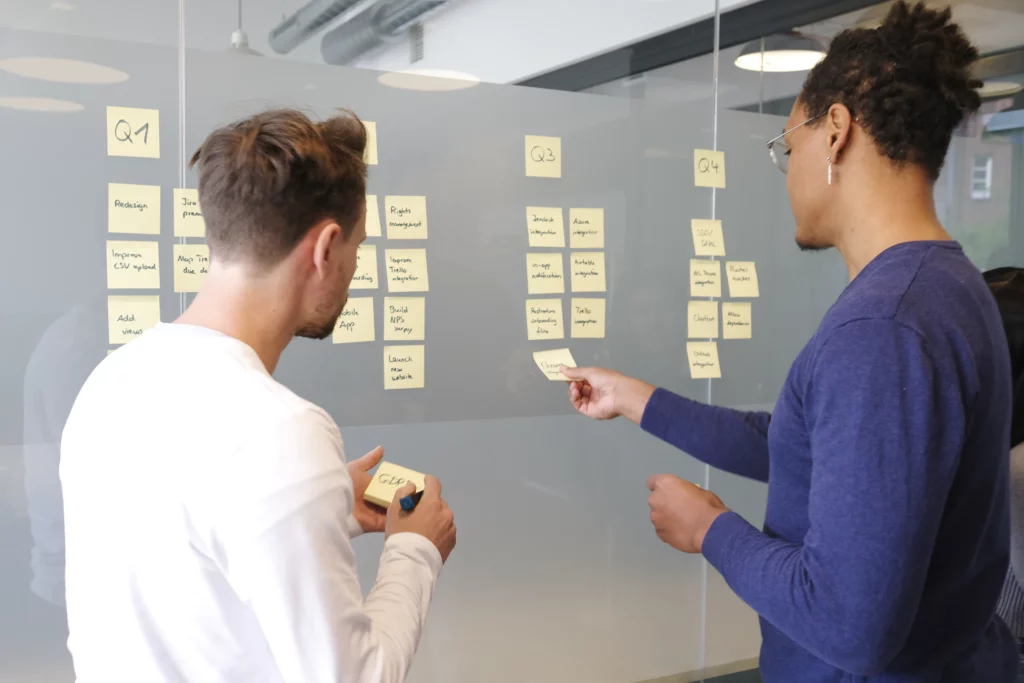The SaaS Application Development Lifecycle
SaaS applications are hosted in the cloud, that is why they can be easily accessed anytime and anywhere.
Key stages of the SaaS Application Development Lifecycle:
- Outlined Vision
- Planning
- Subscription
- Development
- SaaS Implementation & Deployment
Learn the key timelines and essential considerations for your SaaS application development project in this blog.

Table of Contents
As said by Basecamp, a SaaS Project Management & Team Communication tool, the enterprises that purchase the services of SaaS providers will always come out on top with efficient operations and organized teams.
SaaS products are highly beneficial to its users. One of the main draws is, of course, the fact that all of the produced data stays in the cloud, safely managed and stored off-site, relieving you from the hardware purchases and/or update costs, as well as management and operations costs. In addition to that, SaaS allows designated employees to access data from any location. And, in fact, SaaS providers deliver greater security than most enterprises can provide in-house.
To put it shortly, SaaS products provide a great solution with remarcable benefits to businesses struggling with traditional and inefficient in-house systems.Because of said benefits, SaaS is a rapidly expanding niche, many entrepreneurs and developers are getting into the realm of SaaS Application Development to help enterprises solve their issues.
The SaaS development process, whether for external sales or internal use, involves a certain Life Cycle. Each element of that Cycle is critical for creating a useful, effective, and appealing product both for external customers and/or in-house staff.
Table of Contents
Saas Development
SaaS development is unique. It requires a very specific skill-set and an open-minded approach. Now that the world began to acknowledge all the benefits a SaaS can provide, more and more developers want to put out their own SaaS solutions.
Here are some benefits of using a SaaS:
- Lower costs. Since SaaS is both a “cloud” solution and a multi-tenant solution, the prices customers are required to pay are far lower than as if they were to develop their own solution and/or keep their data on-premise.
- Scalability. Being an already developed solution, customers need not do much of capacity planning, as SaaS are highly scalable.
- Upgrades. SaaS provide all the fixes and upgrades themselves, which is highly convenient for their users.
- Integration. SaaS are perfect platforms for integration with other services, which means their customers don’t usually need to buy additional software solutions.
- User Experience. SaaS solutions always strive to make their UX enjoyable and their UI intuitive, which lets their customers spend less time learning how to use the software.
The SaaS Development Life Cycle Begins With The Vision

To develop a great tool you need to conduct a lot of research. Begin by identifying the Need of an organization that is crucial to fulfill. Proceed by gathering ideas and evaluating the market. This will give you an idea of a product that is going to be useful and successful.
The Planning Stage

You can’t develop an idea much without having a great plan. You must understand how are you going to develop your SaaS, how much it will cost, when will you be able to launch it, and how is the marketing strategy going to look. Software Development Strategies for SaaS may help greatly with answering those questions. But do not forget that even the best plans can and should be modified after each project iteration to achieve the best possible results.
The Subscription Stage

After all decisions regarding cost and architecture has been finalized comes the time to choose your cloud provider. While there are many decisions to be made regarding a SaaS platform, the cloud provider selection is, probably, the most important one. Plenty of communication and testing should take place in order to evaluate said provider’s capabilities and performance quality. This process should culminate in a subscription with the provider, accompanied by a detailed overview of the services to be provided.
During this process,backup and disaster recovery plans will be formulated in order to ensure top-tier performance and high service availability to your clients. Each iteration, as completed, should be tested and the cloud provider’s performance audited. The subscription details may have to be modified, which is, in fact, a common practice.
The Development Stage

The Development stage is complex. Many decisions regarding the project’s architecture must be made. Below we listed some of the essential requirements for a SaaS to meet to be considered valuable for customers and profitable for developers:
- Multiple Tenants. There is no point in developing a SaaS unless it is suitable for many users and has potential to scale.
- User Experience. The software must be user-friendly and easy-to-use.
- Security. SaaS must provide an elevated level of security, and its customers must believe in the exceptional security of their data. Encryption, as well as highly secure access conditions are essential practices.
- Customer Support. Built-in support processes, 24-hour access and frequent, non-disruptive updates must all take place.
With these basic practices in mind, the development process will mean the following:
1. Selection of a Software Development Methodology
There is an abundance of methodologies that are known as the “Software Development Lifecycle”. Let’s break down some of the most common ones below:
- Rapid – a prototype is quickly put together to speed-up the development and then tested.
- Iterative – small scale development with subsequent iterations suitable for scaling.
- Spiral – development is divided into cycles, each of which is evaluated to then later influence the next cycle and better the methodology.
- Waterfall – The entire project is developed through a sequence of phases.
- Agile – a type of development where each iteration gets evaluated after it ends, so that positive change and adaptation of plans can take place before the next iteration begins.
Today, the Agile method is the most commonly used among software developers. However, many SaaS project developers do switch back and forth among some of these and many other methodologies as they work through phases of a project. Sometimes, the architectural details demand it.
2. SaaS Will Mean HTML5 (at least for desktops)
New products mean using the HTML5 technology – it is most suitable for today’s environment. This is because it can provide RIA (Rich Internet Applications) with no need for legacy plugins.
When back in 2014 Microsoft announced that they will be discontinuing the support of Windows XP, Microsoft platforms that could not support HTML5 slowly began to die off.
There still may be some lingering issues with the use of HTML5 on mobile devices, but there are less and less of those each day. Nonetheless, testing your software on mobile should at least be considered. If there are any issues, then a native mobile app may be the best course of action.
3. SaaS Requires Published API’s
SaaS products must have API’s that provide for the development of external widgets and extensions by value-added resellers and other third-party developers. An API that will integrate with other software, like Big Data and analytics. If clients cannot access their data any way except through the SaaS package they have purchased, then the vendor must provide the API.
APIs have to be consistent and should be maintained after publishing. Developers must ensure that APIs can be extended, which requires a very thought-through architecture.
4. Multi-Tenancy Issues
SaaS development is, by definition, a server-side development. When multiple clients share a server, the demands on developers are far higher than those for developing for a sole tenant. Reliable security must ensure that each client’s data is isolated from other tenants. This means that developers must decide on a model for multi-tenant storage system. The models are:
- Single-tenant – where each client gets a dedicated database, and
- Multi-tenant – where each individual is accessing their data from a common database via a personal ID.
The decision on the storage model should be based on the client segment you are marketing to.
5. SaaS and Stateless Architecture
Stateless architecture is preferred because it provides smooth performance, elasticity, scalability, and fault tolerance. If applications are stateless, there is no need to allocate storage of previous requests, making the cost lower. These applications can also scale easily, making it perfect for dealing with spikes in usage. Stateful architecture, on the other hand, requires more management and takes up more infrastructure resources.
Stateless architecture is not a requirement for SaaS, though it just may provide the best performance.
6. SaaS Upgrades – Frequent and Non-Disruptive
Upgrades must be built into the architecture in a way that will not disrupt user experience. In general, SaaS companies do not put out a lot of versions out there – usually there are only two. If a new version is developed, it can be done on a separate server without any migrated clients to minimize disruptions.
SaaS companies should be wary of distressing their clients’ experiences, should carefully think through any UI changes that may require additional training, and the software architecture has to be resilient to failure as well as have short failure recovery time.
7. Redundancy and High Availability Level
Software failure, machine instance, data availability, network disruptions, data integrity and more issues are bound to occur. The architecture must be ready to recover from any of the listed issues with ease and with the least disruption to the clients’ experience. Redundancy can be provided by a database platform or by an Infrastructure as a Service. Some IaaS developers will provide their clients with up to three copies of data, ensuring all-time data availability. Data corruption may be the hardest of issues to deal with. It will require the software to be architected in a way to be able to consistently recover data from its prior state.
8. Operations – Requirements for Development
New tenant on-boarding and billing services must be built into the SaaS architecture. The same goes for monitoring, fault and intrusion detection (and remediation), along with security.
The software must also provide for load balancing and making up for on-demand additional resources. IaaS and PaaS providers (if they are used), and third-party tools may help with managing that, though their integration must be in the software product itself. There isn’t a defined model for all of this, which means that the developers will have to get creative.<
SaaS Implementation Methodology and Deployment

Once the software is deployed, frequent updates and security patches should take place to keep the support requests to a minimum while continually improving the UX.Helpdesk calls and/or support tickets all result in increased operational costs, so the goal is to automate those tasks as much as possible and. Remember – constant monitoring and patches/updates will keep your customers happy.
SaaS Development, Operations, and Management are Unique

Anyone considering SaaS development must invest heavily in the talent of the people developing it. This is the most expensive part of the endeavor – the requirement for a very specific skill set. And, if you intend to have a top-rated piece of software – robust, expansion-ready, innovative, with well-received UI and UX, secure, and reliable in its implementation – then you must be prepared for the high costs involved.
Saas Development Tools
SaaS projects are usually complex and oftentimes unique. This means that there is no defined stack of tools for SaaS development. You should base your SaaS development stack off of your project requirements, your software architecture and your marketing strategy.
Nevertheless, some of the more popular tools for SaaS development are listed below:
Server-side development:
- Ruby on Rails
- Python
- PHP
- Node.js
Client-side development:
- JavaScript
- Angular.js
Database management:
- MySQL
- MongoDB
Conclusion
Software as a Service solutions have become the best options for many businesses. Their scalability, availability and pricing policies all provide their users with an abundance of benefits, as well as open new horizons and relieve many business owners of their everyday management headaches.
Either you are looking to adopt a SaaS in your business, or you are planning to develop a SaaS of your own, the concept is as innovative as it gets and it is definitely worth all the attention it has recently been getting.
You Have Another Option
If you have an innovative SaaS idea, bring it to our development team at Romexsoft. We have a group of first-rate pros with years of experience in SaaS development. They will collaborate with you through the entire SaaS lifecycle and produce exactly what you envision. In the end, you will have world-class software to take to the marketplace.





